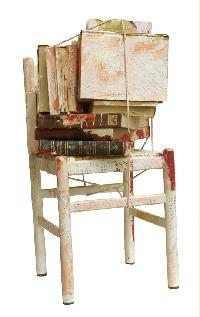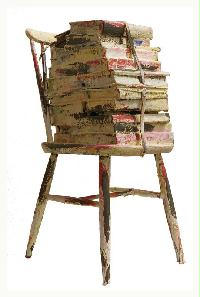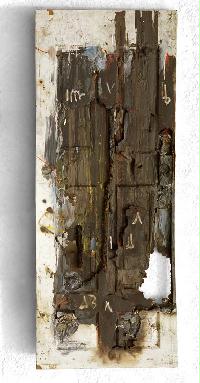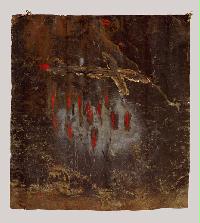Art by Mohammed Al Sadoun Courtesy of Station Museum
Iraqi artist Mohammed Al Sadoun has been engaging viewers with multifaceted explorations of Middle Eastern history and sociopolitical issues for thirty years. His work has been exhibited in international art exhibitions since 1975.
Al Sadoun was born in 1958 and raised in southern Iraq. He received a BFA from the University of Baghdad in 1979 and an MA in art education from the University of Hartford in Connecticut in 1986. Soon after, he began teaching art at Iraqi universities. In 1989 he was invited to Japan where he exhibited consistently for three years. In 1999 he received his PhD from Ohio State University in art education and has been teaching in the United States ever since. His contributions to the progression of the Contemporary Arab art movement include conceptual pieces, paintings, publications, comprehensive research and countless lectures on the evolution of the movement.
Al Sadoun's artwork maintains his dedication to Contemporary Arab art through the constant challenging of the movement's artistic boundaries. In such works as Burnt Door #1, 2005, What I Remember, 1991, and Untitled #1, 2005, Al Sadoun uses unconventional materials and concepts in provocative works that call attention to the complexity of the modern Middle East.
The concept for Burnt Door #1 evolved in the summer of 1986 during the Iraqi war with Iran. While working in his Baghdad studio one day, Al Sadoun heard a strong explosion that shook his downtown neighborhood. Upon investigation, he came across burning houses that had been hit by an Iranian missile. The impact of the missile left beautiful Baghdadi windows and doors burning, leaving Al Sadoun with anger that haunted him, and forcing him to return to the site later that evening. When he returned he found a burnt door. When asked about the impact of the burnt door, Al Sadoun recounts, "I was very interested in the color, texture and accidental fragmentations of the burning in that door, so I took the door to my studio and started working on it. I entered that door in the first Baghdad International Festival of Art in 1986 even though I was afraid that the selection committee might reject it because that kind of art was unknown and unpopular during that period." In 1989, the door was selected for the Iraqi Contemporary exhibition held at the Arab Institute in Paris.

Al Sadoun continues to create such pieces using found doors, fuel, latex, wall paint, acrylic, glues and fire. He involves viewers in the artistic process by burning doors in front of a live audience. The result is an intensely personal experience that captures the horror and devastation of war. Through the process, Al Sadoun and his viewers become perpetrators of the brutal destruction of the aged door. The door is seized, violently assaulted, and then left in a state of disrepair, undecipherable from its original condition. Al Sadoun's doors stand as testimonies of the cataclysmic nature of war and the countless victims that subsequently result.
What I Remember was created during the first Gulf War while Al Sadoun was working in Japan. After viewing the bombing of Iraq by American forces on television, he was overcome by a profound sense of sadness and nostalgia for his native country. The painting resulted from the intensity of his emotional state during this time. While working in an abandoned building that functioned as his studio, he discovered a 19"x27" piece of metal, the quality of which he thought was ideal for a scene depicting the bombing of Iraq.
The composition of What I Remember is simple; a sole plane devoid of a target is shown releasing bombs. There is no indication of Iraq being the subject matter of the piece. Al Sadoun leaves it to the viewer to make his/her own conclusions as to the time and place of his depiction. Given the complicated history of political affairs over the past century, Al Sadoun's scene is pertinent to numerous conflicts. What is made clear is a distinct sense of solitude and ruin. The landscape of the scene lies in abstraction, unrecognizable from the weathered metal. The worn texture of the metal is integrated into the composition through the onerous use of a dark color palette. His recollection of Iraqi houses, whose walls are rich in texture and graphite, inspired such a technique.

Al Sadoun's scene encapsulates a dreamlike reality; the viewer is drawn into the difficult process of remembrance. There is an inescapable sense of desolation conveyed in What I Remember, in which Al Sadoun captures the abandonment of a people left to face the atrocities of war. The scene is chilling yet is an imperative form of commentary on the current state of global affairs, intended to convey the tragedy of violent conflicts.
Untitled #1 is a concept that Al Sadoun has been exploring in recent years. A stack of books is tied with rope to a chair then painted with acrylic paint. In some instances, as in Untitled #1, Arabic writing appears scattered along the entire piece. Notions of education are insinuated through the use of a chair and books while the application of rope and paint join the found objects as one uniform body, constricted to the scrutiny of the viewer's glance.
The body of the piece is unwieldy; the curious tying of books intended to instill a sense of discomfort in the viewer so as to communicate the severity of his message.

Though the physical forms of such pieces are uncomplicated, Al Sadoun makes a profound statement about censorship in the Middle East and the Islamic world. Although literacy has been an integral aspect of Arab and Islamic societies for centuries, Al Sadoun taps into one of the most imperative struggles of modern times. Freedom of speech and artistic liberty are questioned as evidence of his own experience as an artist. Pertaining to the subject of censorship he writes, "Iraq and other Arab and Islamic countries are suffering from awful censorship. These countries forbid expression and deny human rights in particular to women and minorities. The tied books express the suffering of those who have lost their rights because of religion and politics." Though Al Sadoun's work is specific to the Arab and Islamic worlds, the universality of the struggle for civil liberties speaks to all; as he affirms, "Viewers as responsible citizens should fight for their freedom against oppressive and undemocratic forces in our societies."
Al Sadoun's conceptual pieces and paintings are bold and commanding, causing viewers to be drawn into the emotionally charged subject matters that dominate his work. His work often includes found objects in an attempt to add a sense of veracity and symbolism to his creative expression. His use of found objects stems from an academic and artistic conviction that upholds art in the postmodern era as a means through which to explore concepts involving reality therefore bringing art closer to life and the masses.
* Maymanah Farhat is a freelance Writer and Researcher of Visual Arts



